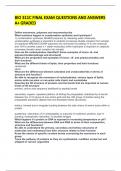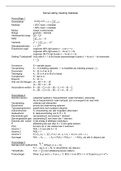Exam (elaborations)
BIO 311C FINAL EXAM QUESTIONS AND ANSWERS A+ GRADED
- Course
- Institution
BIO 311C FINAL EXAM QUESTIONS AND ANSWERS A+ GRADED Define monomers, polymers and macromolecules What reactions happen in condensation synthesis and hydrolysis? 1) condensation synthesis: MAKES polymers by releasing water molecules, condensation synthesis is important in anabolic processes ...
[Show more]





